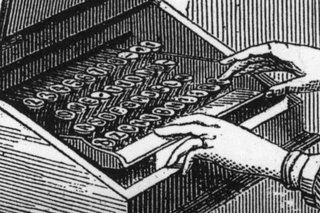So it begins only little more than a century ago, with the fifty-second man to invent the typewriter. Christopher Latham Sholes was a Milwaukee, Wisconsin printer by trade, and a mechanical tinkerer by inclination. Helped by his friends, Carlos Glidden and Samuel W. Soule, he had built a primitive writing machine for which a patent application was filed in October 1867. -- Paul A. David: "Clio and the Economics of QWERTY", The American Economic Review, Vol.75, No.2 (May 1985), pp.332-337.
A printer? Mr. Christopher Latham Sholes was? No. He occupied the government position of Collector of the Port of Milwaukee at that time in 1867 (cf. "Removal of Collector Sholes", Milwaukee Daily Sentinel, Vol.24, No.247 (October 26, 1867), p.1, l.6). He was one of the first Senators of Wisconsin in 1848, and an editor of Wisconsin newspapers including Southport Telegraph, Kenosha Telegraph, Kenosha Tribune & Telegraph, Free Democrat, Milwaukee Daily News, and Milwaukee Daily Sentinel. He might have occupied himself in printing in 1840's, but he seems to have quit it after the scandal on printing the Revised Statutes in 1849 (cf. "The Printing Job", Milwaukee Sentinel and Gazette, Vol.4, No.302 (April 7, 1849), p.2, l.3).
 However, in fact, the keyboard arrangement of the 1872 model (shown right, taken from "The Type Writer", Scientific American, Vol.27, No.6 (August 10, 1872), p.79) were very similar to QWERTY of the 1873 model. Furthermore, in the 1873 model, the letters E and R were in the same quadrant of the typebar circle (cf. Richard E. Dickerson: "Did Sholes and Densmore Know What They Were Doing When They Designed Their Keyboard?", ETCetera, No.6 (February 1989), pp.6-9), though "er" and "re" are very frequently used in English words. Here we conclude that Dr. Dvorak's hypothesis, in which he insisted that QWERTY was intended to avoid the clashing of typebars, is false.
However, in fact, the keyboard arrangement of the 1872 model (shown right, taken from "The Type Writer", Scientific American, Vol.27, No.6 (August 10, 1872), p.79) were very similar to QWERTY of the 1873 model. Furthermore, in the 1873 model, the letters E and R were in the same quadrant of the typebar circle (cf. Richard E. Dickerson: "Did Sholes and Densmore Know What They Were Doing When They Designed Their Keyboard?", ETCetera, No.6 (February 1989), pp.6-9), though "er" and "re" are very frequently used in English words. Here we conclude that Dr. Dvorak's hypothesis, in which he insisted that QWERTY was intended to avoid the clashing of typebars, is false.
